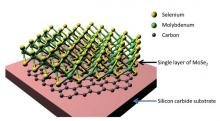One-of-its-kind MBE machine for large-area graphene sheets production
The University of Nottingham unveiled its new Molecular Beam Epitaxy (MBE) machine, capable of reaching the high temperatures required to grow graphene and boron nitride layers on an industrial scale. This is the first machine of its kind in the world, and the researchers are hoping it will "unlock the full potential of graphene in electronics and optoelectronics".
Over £2m were invested in the design, purchase and other costs of the machine, by the Engineering and Physical Sciences Research Council, The University of Nottingham and the Leverhulme Trust. Professor Sergei Novikov, the lead scientist in this project, stresses that this is indeed a high risk project, but one that could potentially change paradigms toward growing large-area graphene and boron-nitride sheets by bonding together carbon atoms at high temperatures.

